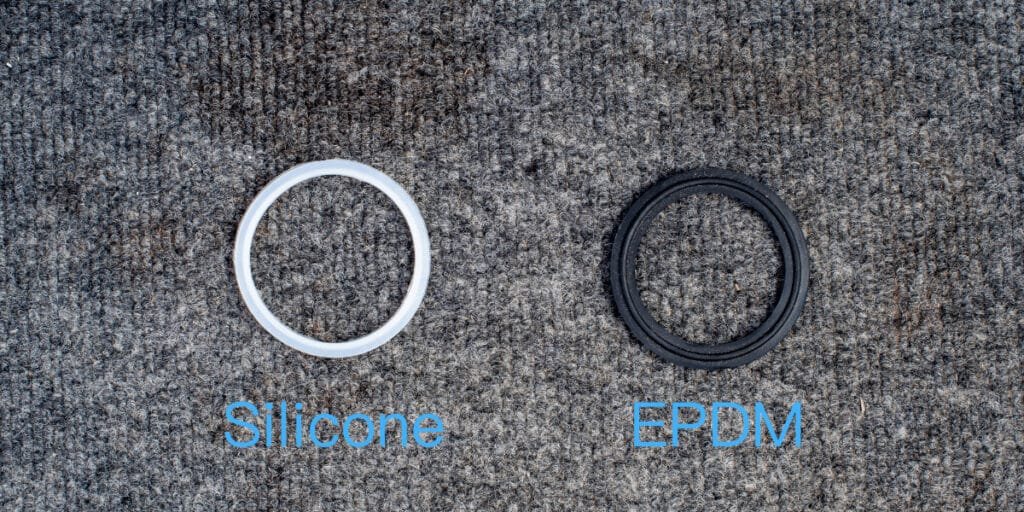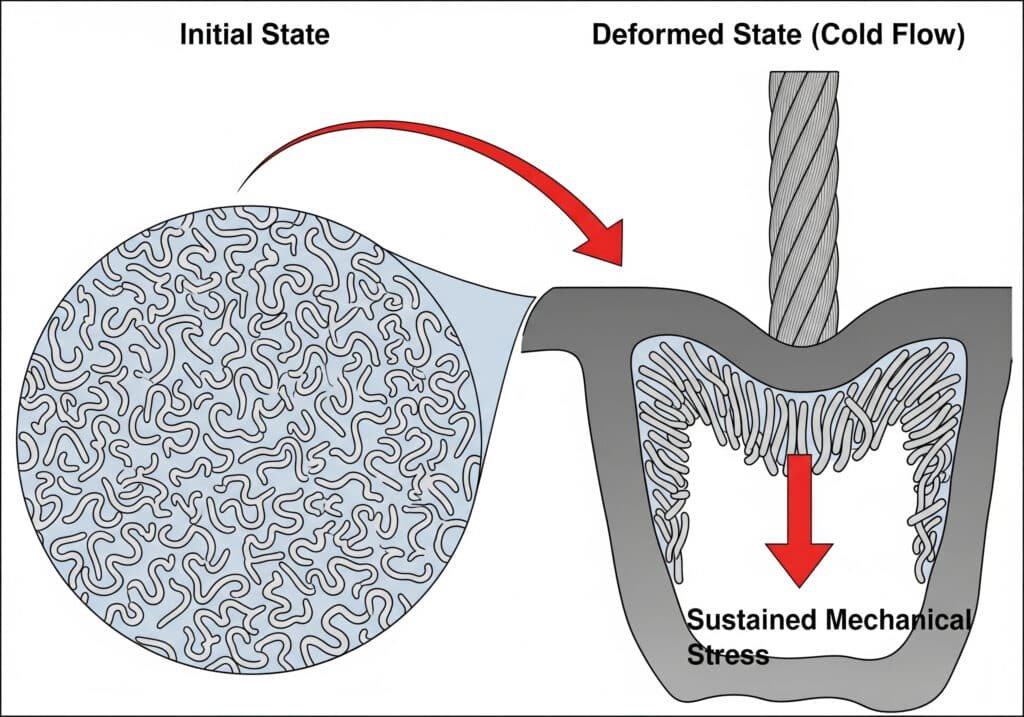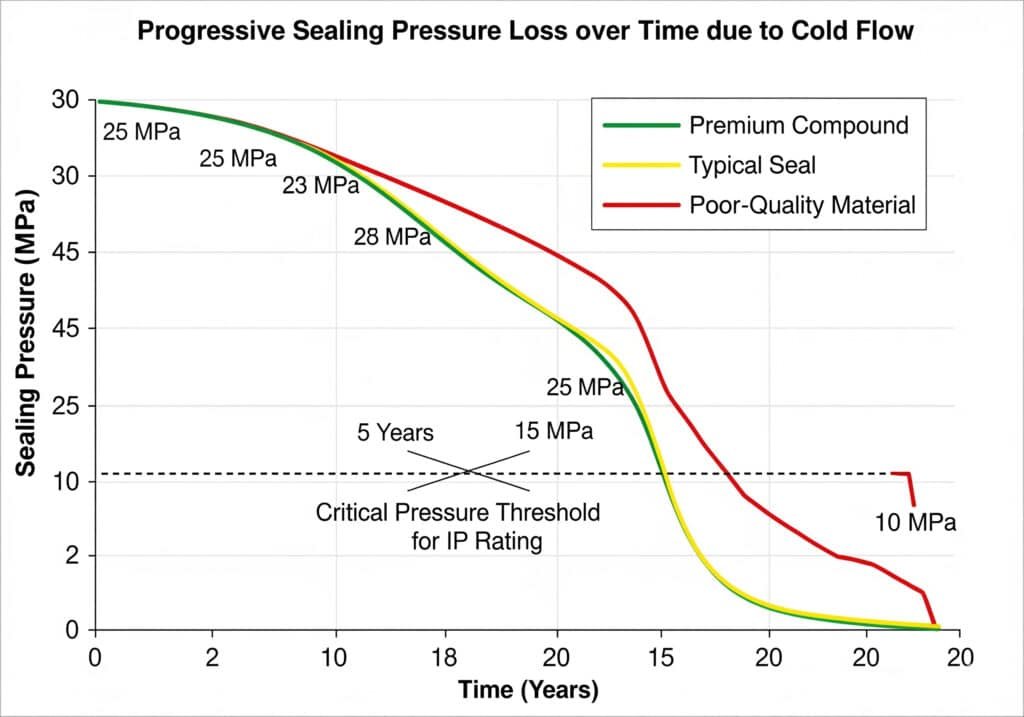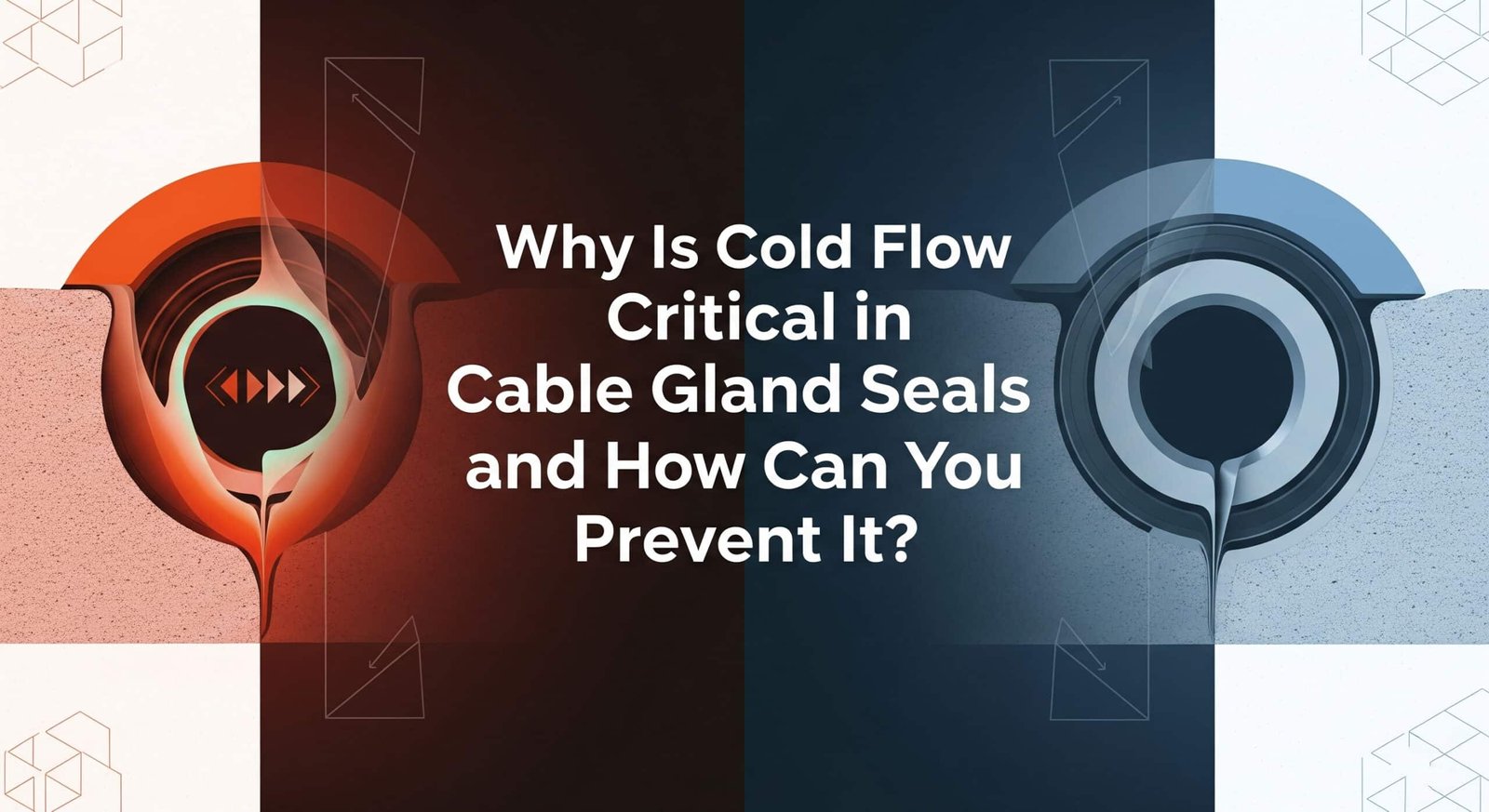
Introduction
Are you experiencing gradual seal failures, declining IP ratings, or mysterious cable loosening in your installations over time? These frustrating problems often stem from cold flow1 – a poorly understood phenomenon that causes elastomeric seals to deform permanently under sustained compression, compromising long-term sealing performance and system reliability.
Cold flow in cable gland seals refers to the permanent deformation of elastomeric materials under sustained compression over time, leading to reduced sealing pressure, compromised IP ratings, and potential system failures. Prevention requires selecting appropriate elastomer compounds, proper compression ratios, and design features that accommodate material flow while maintaining sealing integrity.
As Sales Director at Bepto Connector, I’ve witnessed how cold flow destroys otherwise well-designed installations. Just last quarter, David from a major automotive plant in Detroit contacted us after discovering that 40% of their cable glands had lost sealing integrity within 18 months – all due to cold flow in their original seal materials. His costly lesson illustrates why understanding and preventing cold flow is essential for reliable cable gland performance.
Table of Contents
- What Is Cold Flow and Why Does It Occur in Cable Gland Seals?
- How Does Cold Flow Impact Cable Gland Performance Over Time?
- What Factors Accelerate Cold Flow in Elastomeric Seals?
- How Can You Select Materials to Minimize Cold Flow Effects?
- What Design Features Help Mitigate Cold Flow in Cable Glands?
- How Do You Test and Monitor for Cold Flow in Installed Systems?
- FAQs About Cold Flow in Cable Gland Seals
What Is Cold Flow and Why Does It Occur in Cable Gland Seals?
Cold flow is the permanent, time-dependent deformation of elastomeric materials under sustained mechanical stress, occurring even at room temperature due to the viscoelastic nature2 of polymer chains in rubber compounds. This phenomenon fundamentally differs from elastic deformation because the material cannot return to its original shape after stress removal.

Understanding the Physics of Cold Flow
Molecular Chain Movement
Elastomeric seals consist of long polymer chains that can slide past each other under sustained pressure. Unlike metals that maintain their structure under load, rubber molecules gradually rearrange themselves to relieve stress, causing permanent shape changes that reduce sealing effectiveness over time.
Time-Temperature Dependence
Cold flow rates increase exponentially with temperature following Arrhenius kinetics3. A seal that might maintain integrity for 20 years at 20°C could fail within 2 years at 60°C due to accelerated molecular motion at higher temperatures.
Stress Concentration Effects
Cable gland installations create complex stress patterns in sealing elements. Sharp edges, uneven compression, or cable movement concentrate stresses in localized areas, accelerating cold flow at these critical points and creating preferential failure paths.
Why Cable Glands Are Particularly Susceptible
Sustained Compression Loading
Unlike dynamic seals that experience intermittent loading, cable gland seals remain under constant compression for years or decades. This sustained loading provides continuous driving force for cold flow, making long-term material stability critical for reliable performance.
Complex Geometry Challenges
Cable glands must seal around irregular cable shapes while accommodating thermal expansion, vibration, and occasional cable movement. These geometric complexities create non-uniform stress distributions that promote localized cold flow and eventual seal failure.
David’s Detroit facility learned this lesson expensively. Their original equipment manufacturer used standard NBR seals in high-temperature applications without considering cold flow implications. “We started seeing water ingress after just 12 months,” David explained. “By 18 months, nearly half our glands had compromised sealing. The production downtime for seal replacement cost us over $200,000.”
Distinguishing Cold Flow from Other Seal Failures
Cold Flow vs. Chemical Degradation
Chemical attack typically causes seal swelling, cracking, or surface deterioration, while cold flow creates smooth, permanent deformation without visible surface damage. Understanding this distinction helps identify root causes and select appropriate solutions.
Cold Flow vs. Thermal Cycling Damage
Thermal cycling creates fatigue cracks and surface checking, whereas cold flow produces gradual, uniform deformation. Both can occur simultaneously, but require different mitigation strategies for effective prevention.
Visual Identification Techniques
Cold flow appears as permanent flattening or extrusion of seal material, often with smooth, glossy surfaces where material has flowed. The deformed areas typically show no cracking or surface degradation, distinguishing cold flow from other failure modes.
At Bepto, our advanced elastomer compounds incorporate cross-linking technologies and filler systems specifically designed to resist cold flow while maintaining flexibility and sealing performance across wide temperature ranges.
How Does Cold Flow Impact Cable Gland Performance Over Time?
Cold flow progressively reduces sealing pressure, compromises IP ratings, allows cable movement, and can lead to complete seal failure, creating safety hazards and expensive system downtime. Understanding these impacts helps engineers recognize early warning signs and implement preventive measures.

Progressive Sealing Pressure Loss
Initial Installation vs. Long-term Performance
Newly installed cable glands typically exceed required sealing pressure by significant margins. However, cold flow gradually reduces this pressure over time, eventually falling below minimum thresholds needed for reliable environmental protection.
Pressure Decay Curves
Typical elastomeric seals lose 15-25% of initial sealing pressure within the first year due to stress relaxation and cold flow. Premium compounds may limit this loss to 5-10%, while poor-quality materials can lose 50% or more, leading to rapid failure.
Critical Pressure Thresholds
Most IP ratings require minimum contact pressures between 0.5-2.0 MPa depending on application severity. Once cold flow reduces pressure below these thresholds, environmental protection becomes unreliable, especially under dynamic conditions like thermal cycling or vibration.
IP Rating Degradation Patterns
Staged Failure Progression
Cold flow typically causes gradual IP rating degradation rather than sudden failure. A gland installed with IP67 rating might degrade to IP65 after two years, then IP54 after five years, before complete failure occurs.
Environmental Factor Acceleration
Harsh environments accelerate IP rating loss through cold flow. High temperatures, chemical exposure, and UV radiation all increase cold flow rates, causing faster degradation than laboratory aging tests might predict.
Cable Movement and Mechanical Issues
Reduced Cable Retention Force
As seals deform due to cold flow, cable retention force decreases, allowing cables to move within glands. This movement can damage cable jackets, create additional stress concentrations, and further accelerate seal degradation.
Vibration Amplification
Loose cable retention due to cold flow allows increased vibration transmission, potentially damaging sensitive equipment or creating fatigue failures in cable conductors. This secondary effect often causes more expensive damage than the original sealing failure.
Hassan, who manages a petrochemical facility in Kuwait, experienced these cascading effects firsthand. “We initially noticed minor water seepage during washdowns,” he reported. “Within six months, cable movement had damaged several control circuits, causing a process shutdown that cost us $150,000 in lost production.”
Long-term System Reliability Impact
Maintenance Cost Escalation
Cold flow-related failures often occur gradually across entire installations, creating waves of maintenance requirements that strain resources and budgets. Facilities may face replacing hundreds of glands within short time periods as cold flow reaches critical levels.
Safety and Compliance Risks
Compromised sealing from cold flow can create safety hazards in hazardous area installations or violate regulatory requirements for environmental protection. These risks often carry penalties far exceeding the cost of proper initial seal selection.
Performance Monitoring Challenges
Unlike sudden failures that trigger immediate attention, cold flow degradation occurs gradually and may go unnoticed until significant damage occurs. Regular inspection programs become essential for early detection and preventive maintenance.
Economic Impact Analysis
Direct Replacement Costs
Seal replacement typically costs 3-5 times more than initial installation due to labor requirements, system downtime, and potential cable replacement needs. Premium seals that resist cold flow often pay for themselves through reduced maintenance requirements.
Indirect Consequence Costs
System downtime, damaged equipment, and safety incidents from cold flow failures can cost 10-100 times more than the original seal cost. These indirect costs make cold flow prevention a critical economic consideration for long-term facility management.
At Bepto, our accelerated aging tests simulate 10+ years of service life to validate cold flow resistance. Our premium elastomer compounds maintain over 80% of initial sealing pressure after equivalent 10-year exposure, ensuring reliable long-term performance.
What Factors Accelerate Cold Flow in Elastomeric Seals?
Temperature, compression stress, material composition, and environmental exposure all significantly influence cold flow rates, with temperature being the most critical factor due to its exponential effect on molecular mobility. Understanding these factors enables better material selection and application design.
Temperature Effects on Cold Flow
Arrhenius Relationship
Cold flow rates follow Arrhenius kinetics, doubling approximately every 10°C temperature increase. This exponential relationship means that seals operating at 80°C experience cold flow rates 16 times faster than identical seals at 40°C.
Critical Temperature Thresholds
Most elastomers show acceptable cold flow resistance below their glass transition temperature but experience rapid degradation above specific thresholds:
- NBR (Nitrile): Acceptable below 80°C, rapid degradation above 100°C
- EPDM: Good performance to 120°C, degradation above 140°C
- FKM (Viton): Excellent resistance to 200°C, degradation above 230°C
Thermal Cycling Amplification
Repeated heating and cooling cycles accelerate cold flow by creating stress concentrations and promoting molecular chain rearrangement. Applications with frequent temperature variations require special consideration for cold flow resistance.
Compression Stress Influence
Stress-Strain Relationships
Higher compression stresses provide greater driving force for cold flow, but the relationship is not linear. Doubling compression stress typically increases cold flow rates by 3-4 times, making proper compression design critical for long-term performance.
Optimal Compression Ratios
Most cable gland seals perform best with 15-25% compression ratios. Lower compression may not provide adequate sealing pressure, while higher compression accelerates cold flow without proportional sealing benefits.
Stress Concentration Avoidance
Sharp edges, surface roughness, and geometric discontinuities create stress concentrations that dramatically accelerate local cold flow. Proper gland design incorporates smooth transitions and appropriate surface finishes to minimize these effects.
Material Composition Factors
Polymer Backbone Structure
Different polymer structures exhibit varying cold flow resistance:
- Saturated polymers (EPDM, FKM) generally show better resistance than unsaturated types
- Highly cross-linked compounds resist flow better than lightly cross-linked materials
- Crystalline regions in polymers provide resistance to molecular chain movement
Filler System Effects
Reinforcing fillers like carbon black or silica can significantly improve cold flow resistance by restricting polymer chain movement. However, excessive filler loading may compromise flexibility and sealing performance.
Plasticizer Considerations
Plasticizers improve low-temperature flexibility but often reduce cold flow resistance by increasing molecular mobility. Balancing these competing requirements requires careful compound formulation.
Environmental Acceleration Factors
Chemical Exposure Impact
Aggressive chemicals can accelerate cold flow by:
- Swelling polymer networks and reducing cross-link density
- Extracting stabilizers that normally resist molecular chain movement
- Creating chemical stress that adds to mechanical loading effects
UV and Ozone Exposure
Ultraviolet radiation and ozone exposure degrade polymer chains, reducing molecular weight and accelerating cold flow. Outdoor installations require UV-stabilized compounds or protective housing to prevent accelerated degradation.
Humidity and Water Absorption
Some elastomers absorb water, which can act as a plasticizer and accelerate cold flow. Hydrolysis reactions may also degrade polymer chains, further reducing cold flow resistance over time.
David’s Detroit experience illustrated multiple acceleration factors. “Our plant environment combined high temperatures from nearby furnaces, hydraulic fluid exposure, and constant vibration,” he explained. “The combination accelerated cold flow far beyond what any single factor would have caused.”
Synergistic Effects
Multi-Factor Acceleration
When multiple acceleration factors occur simultaneously, their effects often multiply rather than simply add together. A seal exposed to both high temperature and aggressive chemicals may fail 10 times faster than predicted from individual factor effects.
Threshold Interactions
Some factors create threshold effects where minor increases push systems beyond critical limits. For example, a seal performing adequately at 75°C might fail rapidly at 80°C due to crossing a critical molecular mobility threshold.
At Bepto, our comprehensive testing programs evaluate cold flow resistance under combined environmental stresses that simulate real-world operating conditions, ensuring our seals perform reliably throughout their intended service life.
How Can You Select Materials to Minimize Cold Flow Effects?
Selecting elastomers with high cross-link density, appropriate polymer backbone structures, and optimized filler systems significantly reduces cold flow while maintaining necessary sealing properties. Material selection requires balancing cold flow resistance with other performance requirements like temperature range, chemical compatibility, and cost.
Elastomer Type Comparison for Cold Flow Resistance
Fluorocarbon (FKM/Viton) – Premium Performance
FKM elastomers offer exceptional cold flow resistance due to their highly stable carbon-fluorine backbone and excellent cross-linking characteristics. These materials maintain sealing integrity for decades in demanding applications, justifying their premium cost through superior reliability.
Performance Characteristics:
- Excellent cold flow resistance to 200°C
- Outstanding chemical compatibility
- Long-term stability in harsh environments
- Higher initial cost but lowest lifecycle expense
Ethylene Propylene Diene (EPDM) – Balanced Performance
EPDM provides good cold flow resistance with broad temperature capability and excellent ozone resistance. This versatile elastomer offers optimal balance of performance and cost for many cable gland applications.
Key Advantages:
- Good cold flow resistance to 120°C
- Excellent weather and ozone resistance
- Moderate cost with good performance
- Wide compound availability for specific requirements
Nitrile (NBR) – Standard Performance
NBR elastomers offer adequate cold flow resistance for moderate-temperature applications with excellent oil resistance. While not suitable for high-temperature service, NBR provides cost-effective solutions for standard industrial environments.
Application Guidelines:
- Acceptable cold flow resistance below 80°C
- Excellent oil and fuel resistance
- Most economical option for suitable applications
- Wide availability and established supply chains
Advanced Compound Formulations
High Cross-Link Density Systems
Modern elastomer compounds achieve superior cold flow resistance through optimized cross-linking systems that create more stable polymer networks. Peroxide-cured compounds typically outperform sulfur-cured systems in long-term stability applications.
Reinforcing Filler Optimization
Strategic use of reinforcing fillers like precipitated silica or carbon black improves cold flow resistance by restricting polymer chain movement. However, filler loading must be optimized to maintain flexibility and sealing performance.
Stabilizer Package Selection
Antioxidants, anti-ozonants, and heat stabilizers protect polymer chains from degradation that would accelerate cold flow. Premium stabilizer packages significantly extend service life in demanding environments.
Hassan’s Kuwait facility now uses our premium FKM compounds for critical applications. “The initial cost was 40% higher than standard materials,” he reported, “but we’ve had zero cold flow failures in three years of operation. The reliability improvement easily justifies the investment.”
Material Testing and Validation
Accelerated Aging Protocols
Proper material selection requires accelerated aging tests that simulate long-term service conditions. Standard tests like ASTM D573 provide baseline data, but application-specific testing better predicts real-world performance.
Compression Set Testing
ASTM D395 compression set testing4 measures permanent deformation after sustained compression, providing direct indication of cold flow resistance. Materials showing less than 25% compression set after 70 hours at application temperature typically provide acceptable long-term performance.
Stress Relaxation Analysis
Stress relaxation testing measures how sealing force decreases over time under constant compression. This test directly correlates with field performance and helps predict maintenance requirements.
Application-Specific Selection Criteria
Temperature Classification System
| Temperature Range | Recommended Material | Expected Service Life | Relative Cost |
|---|---|---|---|
| -20°C to +80°C | Premium NBR | 5-7 years | 1.0x |
| -30°C to +120°C | EPDM | 7-10 years | 1.3x |
| -20°C to +150°C | FKM (Standard) | 10-15 years | 2.5x |
| -40°C to +200°C | FKM (Premium) | 15-20 years | 4.0x |
Chemical Compatibility Considerations
Cold flow resistance must be balanced with chemical compatibility requirements. Some chemicals that don’t directly attack elastomers may still accelerate cold flow by acting as plasticizers or affecting cross-link stability.
Cost-Benefit Analysis Framework
Material selection should consider total lifecycle costs including:
- Initial material and installation costs
- Expected service life and replacement frequency
- Downtime costs for maintenance and replacement
- Risk costs from potential failures
Quality Assurance in Material Selection
Supplier Qualification Requirements
Reliable cold flow performance requires consistent material quality from qualified suppliers. Key qualification criteria include:
- ISO9001 quality management systems
- Comprehensive material testing capabilities
- Traceability systems for raw materials and compounds
- Technical support for application-specific requirements
Incoming Material Verification
Critical applications benefit from incoming material testing to verify cold flow resistance properties. Simple compression set tests can identify material variations that might compromise long-term performance.
At Bepto, our material selection process includes comprehensive testing under simulated service conditions, ensuring our recommended compounds deliver reliable cold flow resistance throughout their intended service life.
What Design Features Help Mitigate Cold Flow in Cable Glands?
Effective cold flow mitigation requires gland designs that distribute stress uniformly, accommodate material flow without losing sealing integrity, and incorporate features that maintain compression over time. Smart design can significantly extend seal life even with standard elastomer materials.
Stress Distribution Optimization
Graduated Compression Zones
Advanced gland designs incorporate multiple compression zones with varying stress levels. Initial contact occurs at lower stress to prevent damage, while final compression achieves required sealing pressure without excessive stress that accelerates cold flow.
Surface Geometry Considerations
Smooth, radiused surfaces distribute stress more evenly than sharp edges or corners. Proper surface finish (typically 32-63 μin Ra) provides optimal sealing without creating stress concentrations that promote localized cold flow.
Load Distribution Hardware
Compression plates or washers distribute loading forces evenly across seal surfaces, preventing point loading that creates stress concentrations. These components must be sized appropriately to avoid creating new stress concentration points.
Accommodation Design Features
Controlled Flow Channels
Some advanced designs incorporate controlled flow channels that allow limited seal material movement without compromising sealing integrity. These channels redirect flow away from critical sealing surfaces while maintaining environmental protection.
Progressive Compression Systems
Multi-stage compression allows seals to accommodate cold flow by providing additional compression capability as materials deform over time. Spring-loaded systems can automatically maintain sealing pressure despite material flow.
Backup Sealing Elements
Redundant sealing systems provide continued protection even if primary seals experience significant cold flow. Secondary seals activate as primary seals deform, ensuring maintained environmental protection throughout service life.
Material Containment Strategies
Anti-Extrusion Design
Backup rings or containment features prevent seal extrusion under high pressure or temperature conditions. These features must be designed carefully to avoid creating additional stress concentrations while providing effective containment.
Volume Compensation
Sealed chambers or expansion volumes accommodate displaced material from cold flow without creating excessive pressure buildup. Proper volume calculation ensures adequate accommodation without compromising sealing performance.
David’s Detroit facility now uses our advanced gland designs with progressive compression systems. “The new glands automatically adjust as seals experience cold flow,” he explained. “We’ve extended our maintenance intervals from 18 months to 5 years with these improved designs.”
Installation and Adjustment Features
Torque Control Systems
Proper installation torque is critical for optimal cold flow performance. Built-in torque indication or limiting features help ensure correct installation compression without over-stressing seal materials.
Field Adjustment Capability
Some applications benefit from field-adjustable compression that allows maintenance personnel to compensate for cold flow without complete gland replacement. These systems must be designed to prevent over-compression that could damage seals.
Visual Indication Systems
Compression indicators or witness marks help installers achieve proper compression and allow maintenance personnel to monitor cold flow progression over time. Early detection enables preventive maintenance before seal failure occurs.
Advanced Design Technologies
Finite Element Analysis Optimization
Modern gland designs utilize FEA modeling to optimize stress distributions and predict cold flow behavior under various operating conditions. This analysis identifies potential problem areas before manufacturing, improving reliability.
Composite Seal Systems
Combining different elastomer materials in single seal assemblies can optimize performance for specific applications. Harder materials resist cold flow while softer materials provide sealing conformability.
Smart Monitoring Integration
Advanced glands may incorporate sensors that monitor sealing pressure or detect early signs of seal degradation. These systems enable predictive maintenance and prevent unexpected failures.
Design Validation and Testing
Accelerated Life Testing
Proper design validation requires accelerated testing under conditions that simulate years of service in compressed timeframes. Testing protocols must account for cold flow effects and validate design features under realistic stress conditions.
Field Performance Correlation
Laboratory testing results must correlate with field performance to validate design effectiveness. Long-term field studies provide essential feedback for design optimization and material selection.
Hassan’s Kuwait facility participated in our field validation program for advanced gland designs. “The three-year study confirmed that your stress distribution features reduced cold flow by 60% compared to conventional designs,” he reported. “This data convinced our management to standardize on your advanced glands throughout the facility.”
At Bepto, our design team combines decades of field experience with advanced modeling capabilities to create gland designs that effectively mitigate cold flow while maintaining cost-effectiveness and manufacturing efficiency.
How Do You Test and Monitor for Cold Flow in Installed Systems?
Effective cold flow monitoring requires systematic inspection procedures, appropriate measurement tools, and predictive maintenance strategies that identify degradation before failure occurs. Early detection enables cost-effective preventive maintenance and avoids expensive emergency repairs.
Visual Inspection Techniques
Systematic Inspection Protocols
Regular visual inspections can identify early signs of cold flow before complete seal failure occurs. Inspection frequency should be based on application severity, with critical systems requiring monthly checks and standard applications needing quarterly inspections.
Key Visual Indicators
- Seal extrusion: Material squeezed out from compression areas
- Surface deformation: Permanent flattening or shape changes
- Gap formation: Visible spaces between seal and mating surfaces
- Cable looseness: Reduced cable retention indicating seal relaxation
Documentation and Trending
Photographic documentation of seal condition enables trending analysis that predicts failure timing. Digital records facilitate maintenance planning and help identify problematic gland types or installation locations.
Quantitative Measurement Methods
Compression Force Testing
Portable force gauges can measure actual sealing compression in installed glands, comparing current values to installation specifications. Significant reductions indicate cold flow progression requiring attention.
Dimensional Analysis
Precision measurements of seal dimensions can quantify cold flow deformation over time. Calipers or micrometers provide sufficient accuracy for most applications, while coordinate measuring machines offer higher precision for critical systems.
Leak Testing Procedures
Periodic pressure testing or tracer gas detection can identify compromised sealing before visible damage occurs. These tests should be performed under conditions simulating worst-case environmental exposure.
Predictive Maintenance Strategies
Condition-Based Monitoring
Establishing baseline measurements at installation enables condition-based maintenance that replaces seals based on actual degradation rather than arbitrary time intervals. This approach optimizes maintenance costs while preventing failures.
Statistical Analysis Methods
Tracking cold flow progression across multiple glands enables statistical analysis that predicts failure probabilities and optimizes replacement scheduling. Weibull analysis5 provides particularly useful insights for maintenance planning.
Risk-Based Prioritization
Not all glands require identical monitoring intensity. Risk-based approaches focus intensive monitoring on critical systems while using less frequent inspection for non-critical applications.
David’s Detroit facility implemented our recommended monitoring program after their cold flow problems. “The systematic approach identified glands approaching failure 6-12 months before actual problems occurred,” he reported. “This advance warning eliminated emergency repairs and reduced our maintenance costs by 40%.”
Environmental Monitoring Integration
Temperature Logging
Continuous temperature monitoring helps correlate cold flow progression with thermal exposure, enabling better prediction of seal life and optimization of replacement intervals.
Chemical Exposure Assessment
Monitoring chemical exposure levels helps identify accelerated cold flow conditions and adjust maintenance schedules accordingly. Portable chemical detection equipment can quantify exposure in real-time.
Vibration Analysis
Excessive vibration can accelerate cold flow through dynamic loading effects. Vibration monitoring helps identify problematic installations requiring more frequent inspection or upgraded seal materials.
Advanced Monitoring Technologies
Pressure Transducers
Permanently installed pressure sensors can continuously monitor sealing pressure in critical applications, providing real-time indication of cold flow progression and enabling immediate response to degradation.
Ultrasonic Testing
Ultrasonic thickness gauges can detect internal voids or delamination in seals that may not be visible externally. This technology provides early warning of developing problems before complete failure.
Thermal Imaging
Infrared cameras can identify temperature variations that indicate compromised sealing or developing problems. Hot spots may indicate increased friction from loose seals or electrical issues.
Data Management and Analysis
Digital Record Systems
Electronic maintenance records enable sophisticated analysis of cold flow patterns and help identify systemic issues affecting multiple installations. Cloud-based systems facilitate data sharing and analysis across multiple facilities.
Predictive Analytics
Machine learning algorithms can analyze historical data to predict cold flow progression and optimize maintenance scheduling. These systems improve accuracy as more data becomes available.
Performance Benchmarking
Comparing cold flow performance across different gland types, materials, and applications helps identify best practices and guides future specification decisions.
Hassan’s Kuwait facility uses our integrated monitoring approach combining visual inspection, quantitative measurements, and environmental monitoring. “The comprehensive program identified cold flow trends 18 months before failures would occur,” he explained. “This early warning system has eliminated unplanned downtime and reduced our maintenance costs significantly.”
At Bepto, we provide comprehensive monitoring guidance and support tools that help customers implement effective cold flow detection and prevention programs tailored to their specific applications and operating conditions.
Conclusion
Cold flow in cable gland seals represents a critical but often overlooked factor that can compromise system reliability, safety, and long-term performance. Understanding the physics of cold flow, recognizing acceleration factors, and implementing appropriate mitigation strategies are essential for reliable cable gland installations.
Success requires a systematic approach combining proper material selection, optimized gland design, and proactive monitoring programs. While premium materials and advanced designs require higher initial investment, they deliver superior long-term value through reduced maintenance costs, improved reliability, and prevention of costly failures.
At Bepto Connector, our comprehensive approach to cold flow prevention combines advanced elastomer compounds, optimized gland designs, and proven monitoring strategies. Our ISO9001 and TUV certifications ensure consistent quality, while our extensive field experience validates performance in the most demanding applications.
Remember: cold flow prevention is an investment in long-term system reliability. Choose materials and designs that resist cold flow, implement proper installation procedures, and maintain proactive monitoring programs. This comprehensive approach ensures your cable gland installations deliver decades of reliable service without compromise.
FAQs About Cold Flow in Cable Gland Seals
Q: How can I tell if my cable gland seals are experiencing cold flow?
A: Look for permanent seal deformation, material extrusion around compression areas, loose cable retention, or declining IP rating performance over time. Unlike other seal failures, cold flow creates smooth, permanent deformation without cracking or surface damage.
Q: What’s the difference between cold flow and normal seal compression?
A: Normal compression is elastic and recoverable when load is removed, while cold flow is permanent deformation that doesn’t recover. Cold flow occurs gradually over months or years under sustained compression, unlike immediate elastic compression during installation.
Q: Can I prevent cold flow by using less compression during installation?
A: Reducing compression may slow cold flow but will compromise initial sealing performance and IP ratings. The solution is selecting materials with better cold flow resistance rather than reducing necessary compression levels.
Q: How much does temperature affect cold flow rates in cable gland seals?
A: Temperature has an exponential effect – cold flow rates approximately double for every 10°C increase. A seal lasting 10 years at 40°C might only last 2-3 years at 60°C, making temperature control or premium materials essential for high-temperature applications.
Q: Is it worth paying more for cold flow-resistant materials?
A: Yes, premium materials typically cost 2-4 times more initially but can last 3-5 times longer, reducing total lifecycle costs. The prevention of unexpected failures, emergency repairs, and system downtime usually justifies the higher material investment within the first few years.
-
Learn about the material science of cold flow (also known as creep), the tendency of a solid material to deform permanently under stress. ↩
-
Explore the concept of viscoelasticity, the property of materials that exhibit both viscous and elastic characteristics when deformed. ↩
-
Understand the Arrhenius equation, which describes the relationship between temperature and the rate of chemical and physical processes. ↩
-
Review the official ASTM D395 standard, the definitive test method for measuring the compression set properties of rubber materials. ↩
-
Discover the principles of Weibull analysis, a statistical method used in reliability engineering to analyze life data and predict failures. ↩


